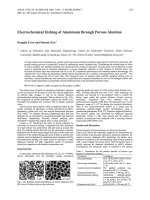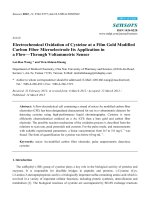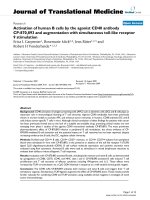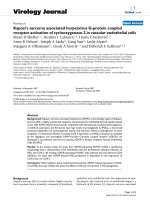electrochemical activation of catalysis 2002 - vayenas, bebelis, pliangos, brosda & tsiplakides
Bạn đang xem bản rút gọn của tài liệu. Xem và tải ngay bản đầy đủ của tài liệu tại đây (19.79 MB, 604 trang )
Electrochemical Activation
of Catalysis
Promotion, Electrochemical Promotion,
and Metal-Support Interactions
Costas G. Vayenas Symeon Bebelis
University of Patras University of Patras
Patras, Greece Patras, Greece
Costas Pliangos Susanne Brosda
University of Patras University of Patras
Patras, Greece Patras, Greece
Demetrios Tsiplakides
University of Patras
Patras, Greece
KLUWER ACADEMIC PUBLISHERS
NEW YORK, BOSTON, DORDRECHT, LONDON, MOSCOW
eBook ISBN: 0-306-47551-0
Print ISBN: 0-306-46719-4
©2002 Kluwer Academic Publishers
New York, Boston, Dordrecht, London, Moscow
Print ©2001 Kluwer Academic/Plenum Publishers
All rights reserved
No part of this eBook may be reproduced or transmitted in any form or by any means, electronic,
mechanical, recording, or otherwise, without written consent from the Publisher
Created in the United States of America
Visit Kluwer Online at:
and Kluwer's eBookstore at:
New York
To our parents and children
FOREWORD
I knew nothing of the work of C. G. Vayenas on NEMCA until the
early nineties. Then I learned from a paper of his idea (gas interface reactions
could be catalyzed electrochemically), which seemed quite marvelous; but I
did not understand how it worked.
Consequently, I decided to correspond with Professor Vayenas in
Patras, Greece, to reach a better understanding of this concept. I think that my
early papers (1946, 1947, and 1957), on the relationship between the work
function of metal surfaces and electron transfer reactions thereat to particles in
solution, held me in good stead to be receptive to what Vayenas told me. As
the electrode potential changes, so of course, does the work function at the
interface, and gas metal reactions there involve adsorbed particles which have
bonding to the surface. Whether electron transfer is complete in such a case, or
whether the effect is on the desorption of radicals, the work function
determines the strength of their bonding, and if one varies the work function
by varying the electrode potential, one can vary the reaction rate at the
interface. I got the idea.
After that, it has been smooth sailing. Dr. Vayenas wrote a seminal
article in Modern Aspects of Electrochemistry, Number 29, and brought the
field into the public eye. It has since grown and its usefulness in chemical
catalytic reactions has been demonstrated and verified worldwide.
Electrochemical Activation of Catalysis contains a very full and
detailed treatment of the mechanisms of electrochemical promotion. It is likely
to remain the standard work on this remarkable new technology; for who other
than the present authors will write a book with such a background of authority
in the field?
What impressed me particularly was the wealth of high standard
theoretical electrochemistry in discussions of the mechanism of NEMCA, for
one seldom sees publications showing so much erudition in the theory of
electrified surfaces. On the other hand, the book contains a very full treatment,
rich in examples, of the practical and experimental side of NEMCA and thus
will be attractive to the chemists and chemical engineers who serve in
corporate research laboratories. It is likely to lead to advances in industrial
vii
viii
FOREWORD
techniques and its long term positive financial value would be difficult to
overestimate.
Thus, there is a great deal of substance to this book on the
electrochemical promotion of catalysis. But the joy is that it has been set down
in a very lucid way so that I seldom had to pause to scan a sentence a second
time for meaning.
NEMCA is a triumph, and the latest in a series of advances in
electrochemistry which have come about in the last 30 years, all of them
situations which are not obviously electrochemical. Examples include
corrosion, metabolism, and (part of) photosynthesis.
Greece, thus far, has shown a wealth of electrochemical talent, e.g., in
the work of Nikitas in adsorption studies, and the hope is that the excellent
contributions of Professor Vayenas and his colleagues will continue to flourish
and expand. Given this abundance of expertise and the improvement the new
method makes to chemical catalysis, I can only hope that Patras will continue
to garner the support that it so richly deserves from the rest of the world.
John O’M. Bockris
PREFACE
Electrochemical promotion, or non-Faradaic Electrochemical
Modification of Catalytic Activity (NEMCA) came as a rather unexpected
discovery in 1980 when with my student Mike Stoukides at MIT we were
trying to influence in situ the rate and selectivity of ethylene epoxidation by
fixing the oxygen “activity” on a Ag catalyst film deposited on a ceramic
conductor via electrical potential application between the catalyst and a counter
electrode.
Since then Electrochemical Promotion of Catalysis has been proven to be
a general phenomenon at the interface of Catalysis and Electrochemistry. More
than seventeen groups around the world have made important contributions in
this area and this number is reasonably expected to grow further as the
phenomenon of electrochemical promotion has very recently been found, as
analyzed in this book, to be intimately related not only to chemical (classical)
promotion and spillover, but also to the “heart” of industrial catalysis, i.e.
metal-support interactions of classical supported catalysts.
Sincerest thanks are expressed to Professor J.O.’M. Bockris, the leading
electrochemist scientist and educator of the 20th century, for inviting me
together with another electrochemist of comparable prominence, Prof. B.E.
Conway, to write a Chapter on NEMCA in “Modern Aspects of
Electrochemistry”, a Chapter which eventually grew into this book. There are
also several other individuals which I and my coauthors would like to thank
cordially. These include, in alphabetical order, Professor C. Comninellis, Dr.
G. Fóti, Professor G. Haller, Dr. K. Howell, Dr. F. Kalhammer and Professor
R. Lambert for reading critically parts of the book and suggesting various
important improvements.
Looking back to the past, sincerest gratitude is expressed to my parents,
grandparents, daughters and other members of my family for their long love
and support. Also to my high school teacher Mr. S. Mantzaras and my PhD
ix
x
PREFACE
Thesis adviser and coadviser at the University of Rochester, Professors H.
Saltsburg and W.D. Smith who taught me the hard work and the joy of
research. Also to my excellent teachers J. Ferron and M. Feinberg at the
University of Rochester and to Gary Haller at Yale and Louis Hegedus, then
at W.R. Grace, both lifelong mentors and friends who introduced me into the
beauty of catalysis and into the art and hardship of technical writing. Also to
Jimmy Wei, Bob Reid and Fred Putnam at MIT who taught me a lot and
who, together with all the other ChE colleagues at MIT in the late seventies,
created a stimulating intellectual and personal environment.
Sincerest thanks are also expressed to Professor Dr. Lothar Riekert
from Mobil and U. Karlsruhe, a true thinker and lifelong mentor and friend
and also to my dear colleague Professor Xenophon Verykios at Patras who
first introduced me to the mysteries of metal-support interactions.
Many thanks are also expressed to Professors V. Sobyanin and V.
Belyaev at Novosibirsk and Dr. Anastasijevic now at Lurgi. Their groups
were the first (1990) to report NEMCA outside Patras. The “loneliness” of
NEMCA disappeared after a sabbatical year at Yale and our first joint
publication in this area with Gary Haller. I am indepted to him and his
excellent coworker Dr. Carlos Cavalca.
Cordial thanks are also expressed to Professor Richard Lambert and
Professor Christos Comninellis, a prominent surface scientist and a
prominent electrochemist whom I first met in 1993 and who both started
working enthusiastically with their excellent groups on NEMCA. The impact
that the groups of Comninellis and Lambert had in shaping electrochemical
promotion in the form we know it today was invaluable. They both brought
in numerous significant ideas described in this book.
Many thanks are also expressed to Professor Milan Jaksic who spent
years in our lab and played a significant role in our first aqueous and Nafion
NEMCA studies. And to Dr. P. Stonehart who from the USA kept sending
valuable samples and advice over the years. Also to Professors S. Ladas and S.
Kennou for their precious collaboration in the first XPS studies proving
backspillover as the origin of NEMCA.
My coworkers and I feel deeply lucky and indebted to have met then Dr.
Fritz Kalhammer from EPRI. Not only was EPRI’s financial support
significant for strengthening our NEMCA work in Patras, but most
importantly, Dr. F. Kalhammer, a former student of G.M. Schwab, understood
and described NEMCA as deeply, eloquently and concisely as nobody, in my
opinion, had ever done before. Fritz’s continuing support and friendship is
gratefully acknowledged, as is that of Dr. H. Pütter of BASF, another
prominent electrochemist whose continuing collaboration is most valuable, as
is BASF’s, Dupont’s and EU’s continuing financial support.
Sincere gratitude is also expressed to my PhD students and postdoctoral
coworkers, as well as the students of other colleagues mentioned above who
PREFACE
xi
spent longer or shorter periods of time with us in Patras, building a good part
of the contents of this book. I am truly indebted to them. They all did a nice job
in establishing electrochemical promotion and elucidating various aspects of
solid state electrochemistry. In chronological order they are: Mike Stoukides
(MIT, now at U. Thessaloniki), Jim Michaels (MIT, now at Merck), Mark
Manton (MIT, now at Shell), Roger Farr (MIT), Jim Mulready (MIT), Pablo
Debenedetti (MIT, now at Princeton). And then at the U. Patras: Ioannis
Yentekakis, my coauthor of this book Symeon Bebelis, Stelios Neophytides.
Their three parallel PhD Theses in the late 80’s showed that NEMCA is a
general phenomenon not limited to any particular catalyst, solid electrolyte or
catalytic reaction. Equally grateful I am to those who followed: Panagiotis
Tsiakaras (now at the Univ. of Thessaly), Christos Karavassilis, E. Karasali,
my coauthor in this book C. Pliangos, Yi Jiang (now at Dalian), A. Kaloyannis,
M. Makri (now at U. Patras), C. Yiokari and my youngest coauthor D.
Tsiplakides whose PhD Thesis significantly enriched the NEMCA literature, as
did the Theses of Carlos Cavalca (Yale) and of Michel Marwood, E.
Varkaraki, J. Nicole and S. Wodiunig, all students of Professor Comninellis at
EPFL, who spent time in our lab and showed truly extraordinary abilities.
Equally indebted I am to my postdoctoral coworkers P. Petrolekas, O. Mari’na,
M. Marwood, C. Pliangos, M. Makri and S. Brosda who did a very nice job in
advancing various aspects of electrochemical promotion and in guiding our
younger PhD students G. Pitselis, C. Raptis, S. Balomenou, A. Giannikos, I.
Bafas, A. Frantzis, D. Polydoros, Th. Bathas, A. Katsaounis, I. Constantinou
and D. Archonta.
Sincerest thanks and gratitude are also expressed to Ms. Soula Pilisi,
our priceless secretary for more than ten years, who typed this book and
always worked diligently for our group in happy and in difficult times.
Costas G. Vayenas
NOMENCLATURE
List of acronyms
AES
CSTR
ECP
EELS
EP
ESCA
G/P
HF
HOMO
HREELS
ICP
IR
LUMO
MSI
NEMCA
OCM
PC
PEEM
PPR
QMS
RPC
SCF
SEP
SERS
SOFC
Auger Electron Spectroscopy
Continuous Stirred Tank Reactor
Effective Core Potential
Electron Energy Loss Spectroscopy
Electrochemical Promotion
Electron Spectroscopy for Chemical Analysis
Galvanostat/Potentiostat
Hartree-Fock model
Highest Occupied Molecular Orbital
High-Resolution Electron Energy Loss Spectroscopy
In-situ Controlled Promotion
Infra Red spectroscopy
Lowest Occupied Molecular Orbital
Metal-Support Interaction
Non-faradaic Electrochemical Modification of Catalytic
Activity
Oxidative Coupling of Methane
Point Charge
Photo Electron Emission Spectroscopy
Potential Programmed Reduction
Quadrupole Mass-Spectrometer
Retarding Potential Curve
Self-Consistent Field
Solid Electrolyte Potentiometry
Surface Enhanced Raman Spectroscopy
Solid Oxide Fuel Cell
xiii
xiv
NOMENCLATURE
STP
STM
TOF
TPD
UHV
UPS
XPS
YSZ
abs
ac, AC
cpd
dc, DC
lhs
o.c.
max
pzc
rhs
rls
she
soe
tpb
Standard Temperature and Pressure
Scanning Tunneling Microscopy
Turnover Frequency
Temperature Programmed Desorption
Ultra High Vacuum
Ultra violet Photoelectron Spectroscopy
X-ray Photoelectron Spectroscopy
Yttria-Stabilized Zirconia
absolute
alternating current
contact potential difference
direct current
left hand side
open circuit condition, I=0
maximum value
point of zero charge
right hand side
rate limiting step
standard hydrogen electrode
standard oxygen electrode
three phase boundaries
List of Symbols
Symbol
a
A
A
C
Ca
D
Meaning
denotes adsorbed species
oxygen activity
electron acceptor adsorbate
solid electrolyte surface area
solid electrolyte-catalyst interface area
gas exposed catalytically active surface
area
capacitance
Carberry number defined in Eq. (5.52)
capacitance of the electrode/electrolyte
interface
surface concentration of backspillover
species
maximum surface concentration of
backspillover species
electron donor adsorbate
Units
Pa
F
F
NOMENCLATURE
xv
D
d
d
E
e
F
f
I
J
Debye
diffusivity of key reactant A
surface diffusivity defined in Eq. (5.6)
catalyst dispersion defined in Eq. (11.1)
thickness of the effective double layer
average grain size of electrode material
atomic diameter
energy
activation energy
catalytic activation energy
chemisorption bond strength
binding energy
binding energy of core level electrons
binding energy of core level electrons
of species in the electrolyte
denotes energy at bottom of the
conduction band
activation energy of desorption
electrostatic energy defined in Eq.
(7.21)
Fermi level
kinetic energy
denotes energy at top of valence band
electric field strength
electron charge
Faraday constant
contact factor defined in Eq. (3.23)
flow rate
frequency
rate of consumption of on the
catalyst surface
change in Gibbs free enthalpy
initial heat of adsorption
heat of adsorption
current
exchange current
exchange current density defined in Eq.
(4.6)
dimensionless current defined in Eqs.
(11.23) and (11.32)
adsorption equilibrium constant of
electron acceptor A
m
m
m
kJ/mol
kJ/mol
kJ/mol
kJ/mol
kJ/mol
kJ/mol
kJ/mol
eV
kJ/mol
kJ/mol
eV
kJ/mol
eV
V/m
Hz
kJ/mol
A
A
xvi
NOMENCLATURE
kL
L
L
n
ñ
O(a)
P
P
oxygen adsorption kinetic constant
Boltzmann constant
adsorption equilibrium constant of
species j
kiloLangmuir
surface diffusion length
thickness of the catalyst film
distance between the centers of the
positive and negative charge in the
adsorbed dipole
three phase boundary length
normalized three phase boundary length
defined in Eq. (5.63)
Avogadro number
surface area of catalyst in mol
surface atom density of the catalyst
surface
length of three-phase-boundaries in mol
normalized length of three phase
boundaries defined in Eq. (5.63)
backspillover sodium ion
overall neutral backspillover sodium
species
number of electrons taking part in the
overall reaction
unit vector normal to the surface
adsorbed oxygen
oxygen ion on regular lattice site
oxygen ion
backspillover oxygen ion
overall neutral backspillover oxygen
species
total pressure
dipole moment, vector
dipole moment of the adsorbate in the
adsorbed state
initial dipole moment of the adsorbate
in the adsorbed state
promotion index defined in Eqs (2.19)
and (4.34)
partial pressure
m
m
m
m
mol
mol
Pa
Cm
Cm
Cm
Pa
NOMENCLATURE
xvii
R
R
R
r
S
T
TOF
t
partial pressure of electron acceptor A
partial pressure of electron donor D
partial pressure of reactants
partial pressure of species j
differential promotion index defined in
Eq. (4.35)
charge of species j
positive partial charge of the adsorbate
negative partial charge of the adsorbate
gas constant
index for reference electrode
resistance
polarization resistance
catalytic rate
electrocatalytic rate
unpromoted catalytic rate
change in catalytic rate
catalytic rate under open circuit
conditions, I=0
preexponential factor
preexponential factor under open
circuit conditions, I=0
entropy change
selectivity
gas phase species
adsorbed species
initial sticking coefficient
temperature
adsorption temperature
peak temperature
temperature of the isokinetic point
turnover frequency
time
cell potential
cell potential under open circuit
conditions
catalyst potential
catalyst potential under open circuit
conditions
change in catalyst potential
Pa
Pa
Pa
Pa
C
C
C
Ohm
Ohm
mol/s
mol/s
mol/s
mol/s
mol/s
mol/s
mol/s
K,°C
K
K
K
s
V
V
V
V
V
xviii
NOMENCLATURE
W
wt%
X
z
Z
oxygen vacancy in the lattice
index for working electrode
weight percent
conversion
distance
impedance
imaginary part of impedance Z
real part of impedance Z
m
Ohm
Ohm
Ohm
Greek symbols
Symbol
Meaning
NEMCA coefficient defined in Eqs. (4.53)
anodic transfer coefficient
cathodic transfer coefficient
enthalpic coefficient defined in Eq. (2.23)
heating rate
permanent rate enhancement ratio defined in Eq.
(4.59)
spreading length of the tpb zone on the electrode
surface defined in Eq. (5.65)
positive image charge, index for partially
positive charged species
negative image charge, index for partially
negative charged species
dielectric constant, electric permeability of
vacuum
overpotential
activation overpotential
overpotential of the counter electrode C
concentration overpotential
ohmic overpotential
promotional effectiveness factor defined in Eq.
(11.25)
coverage
coverage of electron acceptor A
coverage of electron donor D
linearized Na coverage scale defined in Eq.
(4.25)
oxygen coverage
coverage of promoting or poisoning species i
coverage of species j
Units
K/s
m
V
V
V
V
V
NOMENCLATURE
xix
coverage of vacant sites
Faradaic efficiency defined in Eqs (4.19)
partial charge transfer coefficient of electron
acceptor A
partial charge transfer coefficient of electron
donor D
partial charge transfer coefficient of species j
defined in Eq. (6.49)
chemical potential
chemical potential of oxygen in the gas phase
standard chemical potential of adsorbed species j
standard chemical potential of specie j in the gas
phase
electrochemical potential of electrons
electrochemical potential of electrons in the
reference electrode
electrochemical potential of electrons in the
working catalyst-electrode
electrochemical potential of oxygen ions in YSZ
electrochemical potential of oxygen ions on the
gas exposed metal electrode surface
Fermi energy
preexponential factor in the Redhead equation
dimensionless distance, z/L
dimensionless potential or work
function more generally
or (Eq. 6.37) dipole
moment
rate enhancement ratio defined in Eq. (4.33)
rate enhancement ratio due to metal-support
interactions defined in Eq. (11.2)
conductivity
conductivity preexponential factor
NEMCA time constant defined in Eq. (4.32)
promoter lifetime
scan rate in cyclic voltammetry studies
work function
extraction potential
work function of a metal surface at the point of
zero charge
Thiele modulus defined in Eq. (11.22)
kJ/mol
kJ/mol
kJ/mol
kJ/mol
kJ/mol
kJ/mol
kJ/mol
kJ/mol
kJ/mol
S/m
mV/s
eV
V
eV
xx
NOMENCLATURE
change in work function defined in Eq. (2.21)
Galvani (inner) potential
surface potential
Volta (outer) potential
eV
V
V
V
Subscripts
i
j
A
C
D
E
G
MSI
P
R
W
WC
WR
o
index for promoter species, e.g.
index for adsorbed species
electron acceptor adsorbate
counter electrode
electron donor adsorbate
denotes electrode/electrolyte interface
denotes electrode/gas interface
metal-support interaction
promoter adsorbate
reference electrode
working electrode
index for potential or resistance between working
and counter electrode
index for potential or resistance between working
and reference electrode
index for open circuit conditions, I=0
Superscripts
o
*
preexponential factor or initial dipole moment
denotes value at rate maximum
Useful Constants
Symbol
e
F
h
k
0K
Meaning
electron charge
Faraday’s constant
Planck’s constant
Boltzmann’s constant
mass of electron
mass of proton
Avogadro’s number
permittivity of free space
absolute zero of temperature
Pi
Value
-273.15°C
3.14159265358979
NOMENCLATURE
xxi
CONTENTS
Chapter 1
Introduction, Brief History and Basic Concepts
1.1
1.2
1.3
The Phenomenon of Electrochemical Promotion
Basic Concepts and Terminology
Structure of This Book
1
8
10
Chapter 2
Promotion in Heterogeneous Catalysis
2.1
Introduction
2.1.1
Catalysis, Chemical and Electrochemical Promotion: An
Example
2.2
2.3
2.4
Chemisorption and Catalytic Kinetics
Catalytic Kinetics and Promoters
Interactions of Adsorbates Acting as Promoters or Poisons with
Catalyst Surfaces
2.4.1
2.4.2
2.4.3
2.4.4
Definitions
Electropositive (Electron Donor) and Electronegative
(Electron Acceptor) Promoters
Electropositive Promoters: Alkali Metals
Electronegative Promoters
2.4.4.1 Structure of the Adsorbed Adatom Layer and
Adatom Induced Surface Reconstruction
2.5
Adsorption on Surfaces Modified by Electropositive or Electro-
negative Promoters
2.5.1
Adsorption of Gases on Surfaces Modified by Alkali
Promoters
2.5.1.1 CO Adsorption
15
17
20
22
23
23
23
24
30
33
35
35
35
xxiii
xxiv
CONTENTS
2.5.1.1.1
2.5.1.1.2
Alkali Effect on the CO Molecular
Chemisorption
Alkali Effect on the CO Dissociative
Chemisorption
2.5.1.2
2.5.1.3
Adsorption
NO Adsorption
2.5.1.3.1
2.5.1.3.2
Alkali Effect on the NO Molecular
Chemisorption
Alkali Effect on the NO Dissociative
Chemisorption
2.5.1.4
2.5.1.5
2.5.1.6
2.5.1.7
Oxygen Adsorption
Hydrogen Adsorption
Nitrogen Adsorption
Adsorption of Organic Compounds
2.5.1.7.1
2.5.1.7.2
Adsorption of Ethylene
Adsorption of Methanol
2.5.2
Adsorption of Gases on Surfaces Modified by Electronega-
tive Adatoms
2.5.2.1
2.5.2.2
CO Adsorption
NO Adsorption
2.5.2.2.1
2.5.2.2.2
Electronegative Modifiers Effect on
the Molecular NO Chemisorption.
Electronegative Modifiers Effect on
the Dissociative NO Adsorption.
2.5.2.3
2.5.2.4
2.5.2.5
Oxygen Adsorption
Hydrogen Adsorption
Adsorption of Organic Compounds
2.5.2.5.1
2.5.2.5.2
Adsorption of Ethylene
Adsorption of Methanol
2.6
Catalytic Activity on Surfaces Modified by Promoters or Poisons
2.6.1
2.6.2
2.6.3
CO Oxidation on Li-doped Pt(111) Surfaces
Ethylene Epoxidation
Synthesis Gas Conversion Reactions
2.6.3.1
2.6.3.2
Effect of Alkali Promoters
Effect of Electronegative Additives
2.7
Summarizing Comments and Rules
37
42
42
43
43
45
46
48
50
52
52
55
56
56
62
62
64
64
67
68
68
70
72
73
74
77
79
81
82
Chapter 3
Solid Electrolytes, Catalysis and Spillover
3.1
3.2
3.3
Solid Electrolytes
Solid Electrolyte Potentiometry (SEP)
Electrocatalytic Operation of Solid Electrolyte Cells
91
94
96
CONTENTS
xxv
3.4
Spillover-backspillover Phenomena
3.4.1
3.4.2
3.4.3
Phenomenology
Mechanisms: Donor and Acceptor Phases
Thermodynamics and Kinetics of Spillover-Backspillover
Between a Solid Electrolyte and a Metal Catalyst-Electrode
101
101
101
104
Chapter 4
Electrochemical Promotion of Catalytic Reactions
4.1
Experimental Setup
4.1.1
4.1.2
The Reactor and the Gas Analysis System
The Catalyst Film
4.1.2.1
4.1.2.2
General Features
Catalyst Preparation
4.1.3
4.1.4
Counter and Reference Electrodes
Quasireference Electrodes
4.2
Catalyst-Electrode Film Characterization
4.2.1
4.2.2
Catalytic Characterization: Measurement of the Metal/Gas
Interface Area
Electrochemical Characterization: Measurement of the
Catalyst-Solid Electrolyte Exchange Current
4.3
A NEMCA Experiment: Galvanostatic and Potentiostatic
Transients
4.3.1
4.3.2
Electrochemical Promotion Using Conductors
Electrochemical Promotion Using Conductors
4.3.2.1
4.3.2.2
CO Oxidation on
NO Reduction by on
4.3.3 General Features and Comparisons
4.4
4.5
Catalyst Work Function Variation with Potential in Solid
Electrolyte Cells
Definitions, Phenomenology and Key Aspects of Electro-
chemical Promotion
4.5.1
4.5.2
4.5.3
4.5.4
4.5.5
4.5.6
NEMCA Time Constant
Enhancement Factor or Faradaic Efficiency
Rate Enhancement Ratio
Promotion Index
Electrophobic and Electrophilic Reactions
Dependence of Catalytic Rates and Activation Energies
on Catalyst Potential and Work Function
4.5.6.1
4.5.6.2
Catalytic Rate Dependence on and
Local and Global r vs Dependence
4.5.7
Activation Energy and Preexponential Factor Dependence
on Work Function
111
111
113
113
116
117
118
118
119
121
128
128
131
131
134
137
138
140
140
141
146
148
151
152
152
156
164
xxvi
CONTENTS
4.5.7.1
Compensation Effect
4.5.8
4.5.9
Selectivity Modification
Promotional Effects on Chemisorption
4.5.9.1
4.5.9.2
Experimental Results
Electrostatic Interactions of Adsorbates in a
Double Layer
4.5.10
"Permanent NEMCA"
4.6
4.7
Prediction of the Magnitude of the Faradaic Efficiency
Synopsis of the Phenomenology: Reactions Studied so Far
166
168
170
170
175
176
179
181
Chapter 5
Origin of NEMCA
5.1
5.2
5.3
Problems and Methods
A Galvanostatic NEMCA Transient Revisited
Analysis of Rate Time Constants During Galvanostatic Transients.
5.3.1
5.3.2
5.3.3
Introduction
Time constants During Galvanostatic Transients and
Faradaic Efficiency
Transient Analysis and Promotion Index
5.4
Work Function and Electrochemical Promotion
5.4.1
5.4.2
Work Function, Fermi Level, Vacuum Level, Galvani
and Volta Potentials, Dipole Moments
The Work Function of Catalyst Films Deposited on
Solid Electrolytes
5.4.2.1
5.4.2.2
Experimental Results
Implications of the Experimental Results
5.4.3
5.4.4
5.4.5
5.4.6
The Work Function of Catalyst Films Deposited on
Solid Electrolytes: Rationalization of the Potential-Work
Function Equivalence
Spatial Variations
Transients and Measurement of Dipole Moments
Deviations from the Equality in the Changes of Extraction
Potential and Electrode Potential
5.5
5.6
Temperature Programmed Desorption (TPD)
Solid Electrolyte Cyclic Voltammetry
5.6.1
5.6.2
Detection of Adsorbed Species
Potential Programmed Reduction
5.7
AC Impedance Spectroscopy
5.7.1
5.7.2
General Features
Measurement of the tpb Length
5.8
XPS Investigations
5.8.1 XPS in Catalysis and Solid State Electrochemistry
189
191
198
198
200
200
203
203
205
205
206
218
222
223
224
228
233
233
237
237
237
243
244
244
CONTENTS
xxvii
5.8.2
XPS Studies of Metals Supported on Conductors
5.9
UPS Investigations
5.10
5.11
5.12
SERS Investigations
PEEM Investigations
Scanning Tunelling Microscopy
5.12.1
5.12.2
Direct Atomic Scale Observation of Electrochemically
Controlled Spillover/Backspillover
Ordered Promoter Adlattices and Electrochemical
Promotion
5.13
5.14
Quantum Mechanical Calculations
The Effective Double Layer
Chapter 6
Rules and Modeling of Promotion
6.1
6.2
Electron Acceptor and Electron Donor Adsorbates
Electrophobic, Electrophilic, Volcano and Inverted Volcano
Reactions: Rationalization, Rules, and Predictions
6.2.1
6.2.2
Similarities and Differences Between Electrochemical
and Classical Promotion
Promotional Rules
6.2.2.1
6.2.2.2
6.2.2.3
6.2.2.4
6.2.2.5
Electrophobic Reactions
Electrophilic Reactions
Volcano-Type Reactions
Inverted Volcano (Minimum) Type Reactions
More Complex Examples
6.2.3
6.2.4
6.2.5
Connection Between and Adsorbate Coverage
Local Promotional Rules
Practical Considerations
6.3
Rationalization of the Promotional Rules
6.3.1
6.3.2
6.3.3
Derivation of the Experimental Local Rules L1 and L2
from the Fundamental Rules F1 and F2
Experimental Confirmation and First Principle
Rationalization of Rules F1 and F2
Summary of Promotion Rules
6.4
Mathematical Modelling
of Electrochemical Promotion and
Classical Promotion
6.4.1
6.4.2
6.4.3
6.4.4
Introduction
Adsorption in Presence of a Double Layer
Adsorption in Absence of Coadsorbing Species
Adsorption Isotherms, Nernst Equation and Potential-
Work Function Equivalence
254
255
256
257
259
259
264
267
271
279
281
283
285
285
288
289
290
293
295
296
298
299
299
300
302
305
305
306
312
313
xxviii
CONTENTS
6.4.5
Catalytic Kinetics in Presence of a Double Layer
Chapter 7
The Absolute Potential
7.1
7.2
7.3
Introduction
Absolute Potential Scales in Aqueous Electrochemistry
Absolute Potential Scale and Zero Energy Level of Electrons
in Solid State Electrochemistry
7.3.1
7.3.2
The Nature of the Effective Double Layer
Experimental Establishment of the Absolute Potential
Scale
7.4
7.5
7.6
7.7
The Work Function of Catalyst Films Deposited on Solid
Electrolytes: Rationalization of the Potential -Work Function
Equivalence
Definition and Properties of the Absolute Potential Scale in
Solid Electrochemistry
Potential Distribution in a Solid Electrolyte Cell
Absolute Potential of Supported Catalysts
Chapter 8
Electrochemical Promotion with Conductors
8.1
The Use of
Conductors
8.1.1
Complete Oxidation Reactions
8.1.1.1
8.1.1.2
8.1.1.3
8.1.1.4
Ethylene Oxidation on Pt
Ethylene Oxidation on Rh
Ethylene Oxidation on Pd
Oxidation on and
Mixtures: Equivalence of Metal-Support
Interaction and NEMCA
8.1.1.4.1
8.1.1.4.2
8.1.1.4.3
8.1.1.4.4
Equivalence of Metal-Support
Interaction and Electrochemical
Promotion
Catalyst Film Mass and Metal-Solid
Electrolyte Capacitance
Oxidation on
Ethylene Oxidation on
8.1.1
.5
8.1.1
.6
8.1.
1.7
8.1.
1.8
8.1.
1.9
Oxidation on Pt
Oxidation on Pt.
Oxidation on Pt
CO Oxidation on Pt and Pd
CO Oxidation on Ag
315
333
334
336
338
340
345
351
356
358
363
363
363
368
373
374
374
376
376
377
379
381
382
385
390
CONTENTS
xxix
8.1.1.10
CO Oxidation on Ag-Pd Alloys and on Au
8.1.2
Partial Oxidation Reactions
8.1.2.1
8.
1.2.2
8.
1.2.3
and Epoxidation on Ag
Methanol Oxidation on Pt and Ag
Oxidative Coupling on Ag
8.1.3
Dehydrogenation and Hydrogenation Reactions
8.
1.3.1
8.
1.3.2
8.
1.3.3
8.
1.3.4
8.
1.3.5
8.1.3.6
Methanol Dehydrogenation on Ag and Pt
Hydrogenation on Rh
Hydrogenation on Pd
CO Hydrogenation on Pd
Methane Reforming on Ni
Dehydrogenation on Pt
8.1.4. NO Reduction Reactions
8.1.4.1
8.1.4.2
8.1.4.3
8.1.4.4
NO and Reduction by CO on Pd/YSZ
NO Reduction by on Pt/YSZ
NO Reduction by and CO on Rh/YSZ in
Presence of Oxygen
Electrochemical Promotion of a Classically
Promoted Rh Catalyst for NO Reduction by
CO in Presence of
8.2
The Use of Conductors
8.2.1 CO Oxidation on
8.3
The Use of Mixed Conductors
8.3.1
8.3.2
Oxidation on
Oxidation on
Chapter 9
Electrochemical Promotion with Cationic Conductors
9.1
The Use of Alkali Ion Conductors
9.1.1
9.1.2
9.1.3
9.1.4
9.1.5
Ethylene Oxidation on
Ethylene Oxidation on Pt/NASICON
CO Oxidation on
Ethylene Epoxidation on
NO Reduction Studies on
9.1.5.1
9.1.5.2
9.1.5.3
9.1.5.4
NO Reduction by on
NO Reduction by CO on
NO Reduction by on
NO Reduction by on
9.1.6
9.1.7
9.1.8
Benzene Hydrogenation on
Hydrogenation on Pd
Selective Hydrogenation on and
390
393
393
398
402
403
403
406
408
409
410
411
411
411
412
414
417
420
420
420
420
428
435
435
440
442
445
446
447
447
449
451
452
453
453









